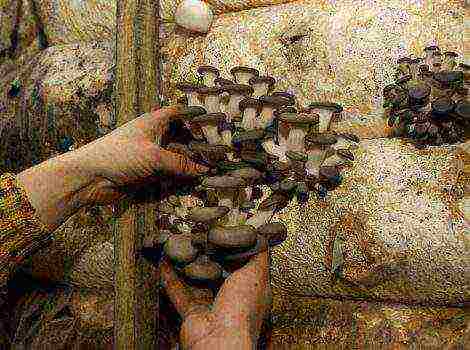Content
- 1 Description of the banana plant for home cultivation
- 2 Varieties of banana for home
- 3 Germinating seeds from a purchased banana
- 4 Transplanting a germinated plant
- 5 Rules for caring for indoor banana tree
- 6 Video: How to sprout a banana from seeds
- 7 A bit of history
- 8 Description, cultivation and care at home
- 9 Possible difficulties
- 10 How to grow bananas at home? Video.
 The opportunity to have an exotic plant in your home always attracts amateurs. The article will discuss how to grow a banana at home (indoor) conditions from the seeds of a purchased fruit. Videos and photos will help you better understand everything.
The opportunity to have an exotic plant in your home always attracts amateurs. The article will discuss how to grow a banana at home (indoor) conditions from the seeds of a purchased fruit. Videos and photos will help you better understand everything.
Banana plant. Varieties for growing in the room
General view and biological characteristics of the plant:
- The height of a banana tree in the tropics reaches 10-12 m.To grow at home, there are dwarf varieties that grow no more than 2 m.
- The length of the leaves is 1.5-2 m, the width is 30-50 cm.
- Their bases are very close to each other, thus forming a plant trunk (pseudostem).
- The stem itself (rhizome) is underground. It has a spherical shape and in parallel performs the functions of a rhizome.
- The inflorescence emerges from the middle of the pseudostem, which dies off after fruiting.
Attention! The banana tree is not a tree at all. It is a herbaceous perennial plant.
The life span of the rhizome of each banana tree is about 40 years. New ones grow in places of drying up pseudostems. On an industrial scale, bananas are propagated by dividing the rhizome, that is, the basal processes are planted. This way all varietal qualities are fully preserved. Plants grown from seeds are used for decorative purposes. Their fruits, most often, are unsuitable for human consumption.
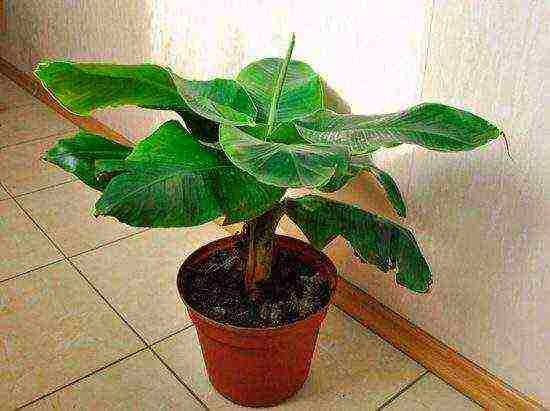
Banana tree
At home, amateurs grow both varieties of bananas with very tasty fruits, and trees that decorate the interior. The average height of such plants is 2-2.5 m, and some dwarf varieties are 1-1.5 m. The first ones include:
- Pointed banana;
- dwarf Cavendish banana;
- banana Cavendish super dwarf;
- Kiev dwarf;
- Kiev super dwarf.
Attention! You can get banana fruits in a room only with proper care.
Decorative varieties:
- Velvety banana;
- Lavender banana;
- Chinese dwarf;
- Bright red banana.
These varieties bloom very beautifully and can produce small, inedible fruits.
How to get seeds from a purchased banana and germinate them
To independently obtain seeds from a purchased banana, you will need to follow these steps:
- A banana with a yellow peel is placed in a plastic bag until it darkens completely.
- Peel the flesh and cut it lengthwise to the level of the pith.
With a sharp object, remove the seeds from the pulp and lay them out one by one on a paper napkin.
Attention! Only round seeds are suitable for planting. Flat specimens should be selected and discarded.
- To separate from the pulp, the seeds are washed well.
- The resulting material is poured with warm water and left for 2-3 days.
- Rinse well again and dry.

Take seeds from dark-skinned fruits
Then the seeds are germinated, which requires an inert substrate. Sphagnum or coconut, which can be purchased at specialty stores, will do. The substrate must be steam sterilized. After cooling, it is mixed with perlite and poured with a solution of potassium permanganate.
If it is impossible to acquire a substrate from plant fibers, you can use a mixture of coarse sand and peat (3: 1). Germinate banana seeds in this way:
- The bottom of the container is covered with drainage material. A layer of substrate 5-6 cm thick is placed on top.
- The seeds are pressed into the substrate and watered well.
Attention! The shell of banana seeds is very dense, therefore, its integrity should be violated before germination. This can be done by rubbing between sheets of sandpaper, scratching the shell with a needle, or shallow cuts with a nail file. The main thing is not to overdo it and not damage the kernel.
- To preserve moisture, they arrange a greenhouse made of polyethylene.
- During the day, the temperature is maintained within +27 .. + 33 ° C, and at night +20 .. + 25 ° C.
Seeds germinate for a long time - from 2 to 3 months. To eliminate mold that may appear during this time, it is enough to treat the substrate with potassium permanganate.

Planting a banana
How to plant and care for a sprouted plant
To grow a banana plant, take the top layer (5-7 cm) of soil from under hazel, birch, linden and acacia. Sand, humus and ash are added to the soil collected in this way in a ratio of 10: 2: 1: 0.5, respectively. The whole composition is mixed and calcined in the oven. The bottom of the pot is lined with drainage material. Moistened sand is poured over it, and only then prepared soil.
Advice. To prevent the pot from adjoining closely to the pallet, you can put several small stones or a grate between them. This technique will allow air to penetrate unhindered to the roots.
The germinated seed is buried in the soil no more than 2 cm, sprinkled and watered well. After the banana grows up and the roots "take over" the entire space of the pot, it is transferred into a larger container.
Caring for a banana in a room consists of performing the following work:
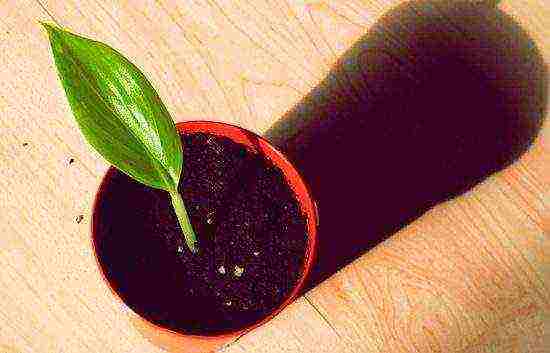
Water the banana as the soil dries
- Regular loosening of the soil.
- Watering. It should be done infrequently, but abundantly. The indicator is the drying of the upper (1-2 cm) layer of soil in the pot.
- Spraying. In winter, this is done once a week, and in summer, every day.
- Maintaining the temperature regime. The acceptable temperature for a banana is +25 .. + 30 ° C. At + 15 ° C, plant growth and development are greatly slowed down.
- Lighting. Banana is only suitable for the south and east sides in dwellings. In winter, you need to provide additional lighting.
- Feeding. Fertilizer should be applied regularly. Vermicompost, herbal infusion will do.
Growing a banana from seeds is troublesome. But after all the efforts, you can enjoy yourself and surprise your friends with a beautiful exotic plant, which may become the main decoration of your home.
Growing a banana at home: video
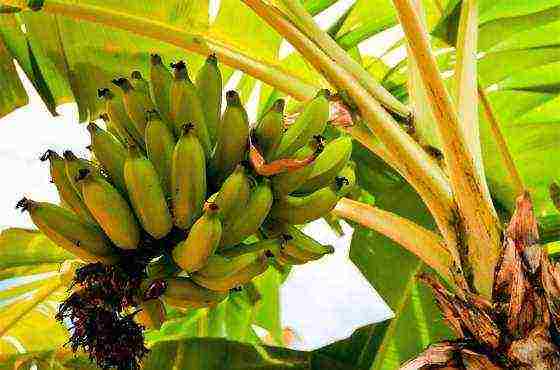
Amateur flower growers are always attracted by the opportunity to grow some exotic plant at home, unusual for the area. Surely every person had a dream to have fragrant citrus fruits or ripe bananas at hand. Today you will learn how to grow a banana at home from the seeds of a purchased fleshy fruit.
Description of the banana plant for home cultivation
If you doubt whether it is possible to grow a banana at home, then we will answer - you can, but be prepared for the fact that this is a rather troublesome business. To grow a banana at home, you need to familiarize yourself with the features of this plant:
- Tropical varieties grow up to 10-12 meters, and the home banana tree is dwarfed, and its height does not exceed 2 meters.
- The foliage is about 1.5 m long and 30 cm wide.
- The bases of the leaves are so tightly adjacent to each other that in this way a pseudostem (plant trunk) is formed.
- And the stem itself (rhizome) is hidden underground. It has the shape of a ball, and in parallel performs the functions of the roots of a tree.
- The main inflorescence grows from the middle of the pseudostem, which dries up after the end of the fruiting process.
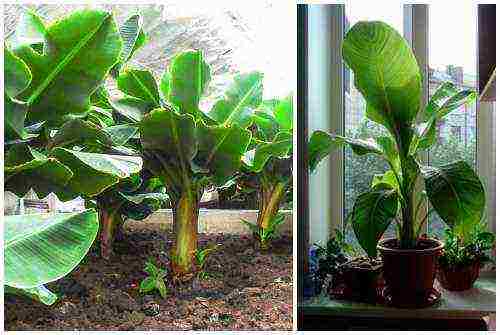
Important! Remember that a banana is not really a tree. In theory, it is a perennial herb.
- The life span of a banana is about 40 years.New pseudostems grow in place of the dying ones. If growth occurs on an industrial scale, then reproduction takes place by dividing the rhizome, in other words, the basal processes are deposited. When the process is planted from the rhizome, it retains all the varietal characteristics of the plant. But specimens grown from seeds are used for decorative purposes.
Varieties of banana for home
Modern florists with equal success grow both decorative "trees" for the purpose of decorating a room, and plants with tasty, juicy fruits. On average, such specimens grow from 2 to 2.5, and mini bananas only reach 1-1.5 meters.
Fruit varieties popular for growing at home include the following bananas:
- pointed;
- dwarf Cavendish;
- Cavendish super dwarf;
- dwarf Kiev;
- superdwarf Kievsky.
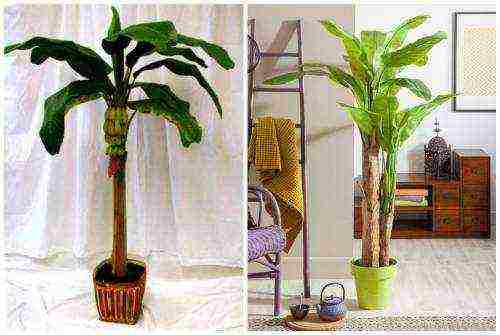
The decorative varieties of exotic plants include:
- lavender;
- velvety;
- Chinese dwarf;
- bright red.
These varieties bloom brightly and beautifully, but the fruits of the banana tree in these varieties are inedible, small.
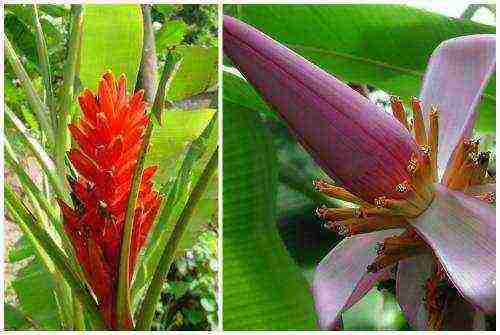
Germinating seeds from a purchased banana
If you are wondering how to grow a banana from seeds, you first need to buy wild fruits from the store. They are extremely rare, but normal fruits are not suitable as they are harvested for export while their seeds are in their embryonic state. Wild fruits are small in size and have dark seeds in the pulp.
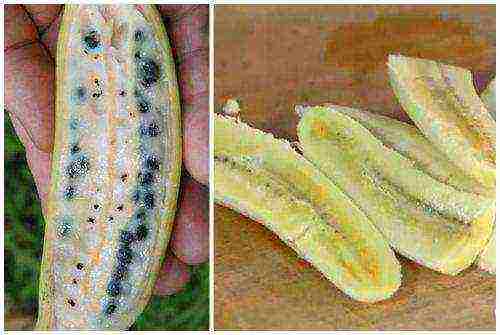
If you managed to find the desired fruit, make sure that there is no damage to the skin. To extract seeds from a purchased banana with your own hands, you need to follow these steps:
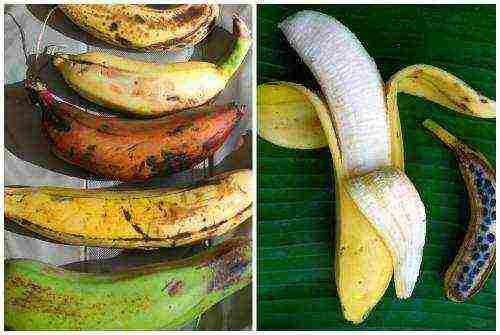
- The yellow fruit is placed in a plastic bag, after which they wait until the peel is completely darkened.
- After that, the fruit is taken out, the flesh is peeled, and an incision is made along the middle. With a sharp object, remove the seeds from the inside and lay them out one by one on a paper napkin.
Important! You should carefully sort out the seeds, since only grains rounded in shape are suitable for planting, and flat specimens should be selected and discarded.
- After the seeds are separated from the pulp, they are thoroughly washed.
- Pour the resulting seeds with warm water, then leave them alone for 3 days.
- At the end of the three-day period, rinse and dry the seeds.
- After completing the preparation process, an inert substrate will be required. For these purposes, coconut or sphagnum are suitable, which are easily bought in flower shops. Before use, the substrate is sterilized with steam, then wait for cooling, mixed with perlite and poured with a solution of potassium permanganate.
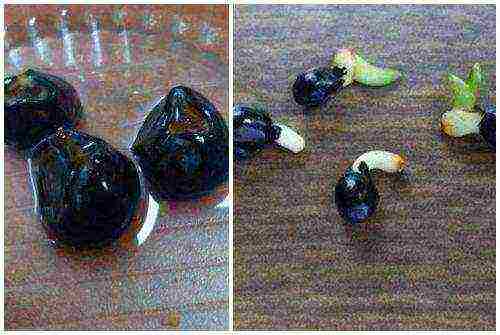
If you do not have the opportunity to purchase coconut or sphagnum, you can use a mixture of peat and coarse sand in a ratio of 1: 3. To do this, cover the bottom of the container with drainage material (gravel, broken brick, foam), on top of which place a layer of substrate 5-6 cm thick. Squeeze the seeds well into the spread mixture, then water the plant.
The shell of banana seeds is very dense, therefore, before immersing them in the soil, its integrity should be mechanically disturbed. This can be done by rubbing the surface with sandpaper, scratching or surface cuts with a nail file. It is important not to overdo it and not damage the kernel.
The process of emergence of the first shoots takes from 2 to 3 months.
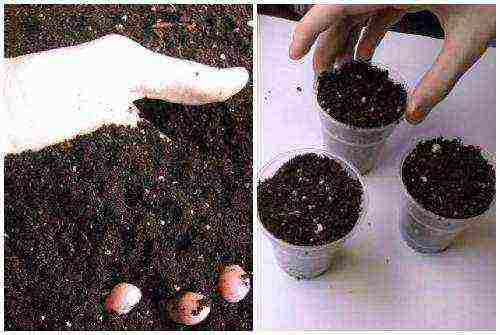
Important! Extraction of seeds is a laborious process, so we recommend purchasing ready-made seeds from a gardening store.
Transplanting a germinated plant
Before you grow a banana tree, you need to take care of replanting it from a germinated seed. The scheme of actions is as follows:
- Take the topmost soil layer (5-7 cm) from under the hazel, linden, birch or acacia.
- Add sand, humus and ash to the collected substance in proportions of 10: 2: 1: 0.5. Mix the resulting composition and send it to the oven for calcination for 5-10 minutes.
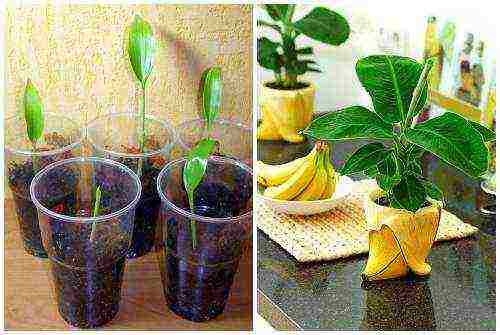
- Cover the bottom with drainage material, and pour moistened sand on top of it. Already after the sand, place the prepared warm soil, calcined in the oven.
Interesting! To prevent the pot from adjoining the pallet, place a grate or a few pebbles between them. Thus, air can penetrate to the roots without obstruction.
- The sprouted seed is deepened into the soil to a depth of about 2 cm, lightly sprinkled and watered.
- The indoor plant should grow, and the roots will eventually "take over" the entire area of the pot. In this case, the banana must be transplanted into a larger container.

Rules for caring for indoor banana tree
Taking care of an exotic plant is quite simple:
- Loosen the soil regularly.
- Water abundantly, but infrequently. Drying of the topsoil in a pot 1-2 cm deep will serve as an indicator.
- Spraying in summer is done daily, and in winter it should be done once a week.
- It is necessary to strictly monitor compliance with the temperature regime so that the tree does not dry out. The optimum temperature for growth is + 25 + 30. Less is possible, but already at +15, the development and growth of the plant slows down significantly.
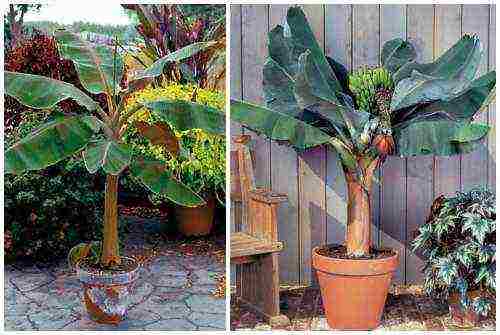
- With proper care, the banana grows and develops at an accelerated pace, and after the appearance of 11-15 leaves, the tree blooms.
- Indoor tree lighting is essential. Place the pot on the south and east side of the dwelling, and provide additional lighting during the winter season.
- Top dressing should be applied systematically. It takes place once a week in the summer with the help of humus and wood ash. Take 200 grams of humus, dilute it in a liter of water and leave it for a day to infuse the solution. Introduce into the soil while watering.
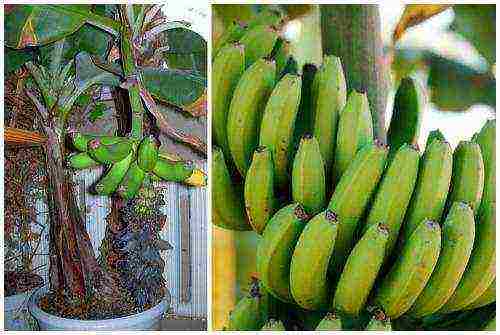
- Water the tree with a weak solution of potassium permanganate once every six months.
- It is better to exclude inorganic fertilizers.
- Under natural conditions, the tree can be affected by root nematodes: black weevil, roundworms, fungus. At home, pests practically do not bother the tree, sometimes a spider mite appears as a problem, which appears when the humidity is low.
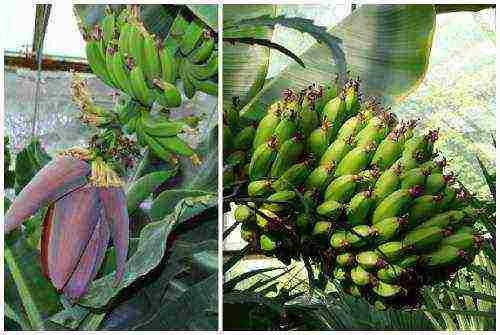
You can skip the seed preparation and sprout rooting period, and just buy a banana tree at a florist's shop, but growing exotic with your own hands is exciting, and the result is much more appreciated. After the applied diligence, you can enjoy the result and surprise guests with an exotic plant that can become the main decoration of your home.
Video: How to sprout a banana from seeds
Growing banana in home conditions.

There is an opinion that it is almost impossible to grow a tropical or subtropical plant at home. For example, a banana is a plant from the tropics, a lover of a humid and warm climate. How will he feel in room culture? And is it possible to grow a banana from a seed, and even eat homemade exotic fruits?
Plant features
Many people are used to thinking of a banana as a palm tree and are extremely surprised that it is a large herb. It is demanding to care for (you need to create conditions for it close to the tropics), but it is quite amenable to home cultivation. Moreover, the fruits can also be obtained.
The perennial representative of the Banana family literally has no trunk. What we consider to be the trunk of a "tree" is the closely spaced bases of oblong leaves (pseudostem). The rhizome (rhizome) hidden underground is the real stem. An unusual plant, in which everything is not like other cultures, but "upside down".
Refers to monocarpic crops: after the completion of fruiting, the ground part of the plant dies off. The rhizome gives rise to a new plant, forming shoots. The banana quickly builds up the ground part: a leaf grows in a week. It begins to bloom in room culture in the third year. A flower forms at the top of the leaf.Moreover, a banana can bloom throughout the entire growth period, gradually forming a bunch of fruits that ripen unevenly.
Although banana is a herbaceous plant, in the wild it grows to a great height (9-12m). Low-growing (dwarf) varieties have been created specifically for cultivation at home.
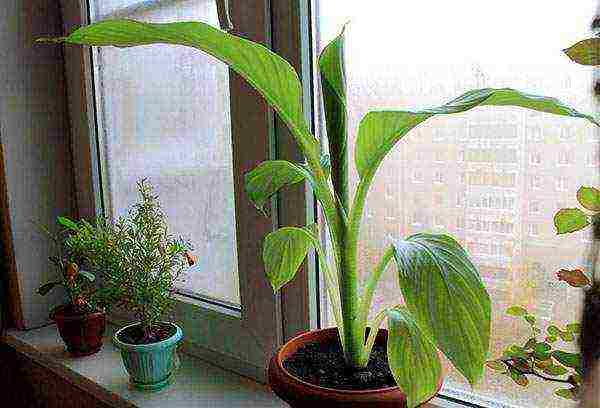
Breeding methods:
- seeds;
- basal processes;
- dividing the rhizome.
Important! The bananas we eat are seedless. These are the fruits of the Cavendish varieties that can only be propagated vegetatively. Those that can be grown by seeds are almost inedible: inside the banana there is an abundance of seeds and little pulp. They are grown for decorative purposes.
Indoors, a banana can be propagated in two ways:
- Plant with seeds. It will be a wild subspecies, strong and viable, but its fruits are inedible, since there is little pulp in them.
- Purchase a germinated plant. It is, as a rule, a varietal crop obtained vegetatively, capable of "producing" tasty, edible fruits.
It is interesting!
In some tropical countries, banana accounts for the lion's share of exports. In terms of sales to other countries, this crop ranks 4th in the world, behind rice, wheat and corn. About 40 species are part of this genus.
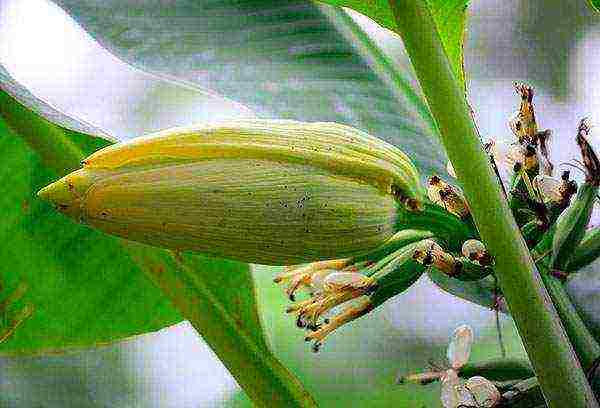
Species grown in room culture
Species are conventionally divided into two groups:
- Decorative, the cultivation of which at home is intended for a variety of interiors, for landscaping an apartment. Their fruits are also a kind of decoration, but they are inedible. These include bananas: velvety, lavender, bright red, Chinese dwarf. All of them reach about one and a half meters in height.
- Fruit species are decorative, and they ripen fruits with good taste. This is a pointed banana, dwarf Cavendish, super dwarf Cavendish, Kiev dwarf, Kiev super dwarf. Their height varies from one meter to two.
It is interesting!
The Ukrainian breeder, who was engaged in the cultivation of this crop at home, claims that the yield of the above species is 150 fruits from one "herb tree".
Read also: Clay plates for flowers
The seeds of this culture take a long time to germinate, like most seeds of tropical plants. Therefore, you can buy an already germinated plant. Subject to all care requirements, it will bloom and bear fruit in a room culture. After purchasing, be sure to transplant the banana into suitable soil, drainage and create the necessary conditions for growth.
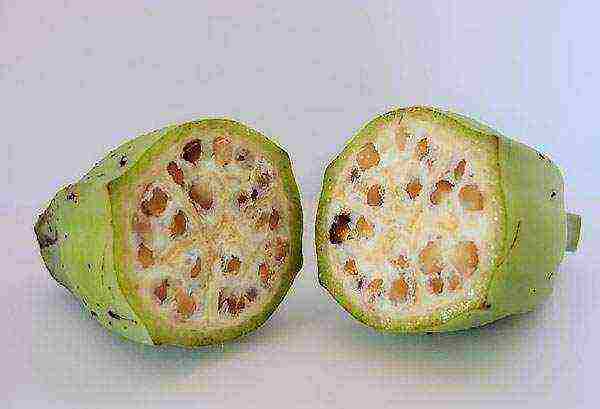
Seed Tropical Plant: Difficult or Simple?
The seeds can be purchased at the store. As a rule, the package contains 3-4 seeds. According to customer reviews, they sprout, but not as quickly as we would like.
How to properly plant at home? Let's consider in stages.
- The seed has a dense shell, so it will be difficult for it to hatch. For this, there is a technique called scarification: a strong shell must be filed, but not piercing or damaging the contents. The main thing is to give the sprout an opportunity to come out into the light.
- You can plant seeds in separate containers, or in a planting box at a distance of 15 cm between future seedlings.
- A separate technique is the germination of seeds in advance in a moist coconut substrate mixed with perlite. The substrate is poured into a plastic bag and mixed with the seeds. Tied, pierced several holes in it. They are placed in a warm place, and after 2 weeks, the seeds that have hatched are planted in pre-prepared pots.
- The potting medium for banana seeds is river sand and peat (4: 1). Top dressing is not needed, but drainage is needed for further cultivation. You can also prepare another soil mixture - this is forest turf with decayed leaves and needles. They are excellent disinfectants. The mixture will have the following composition: forest turf, wood ash, sand and peat in equal proportions.
- Seeds planted at home in the spring-summer period germinate after 3-5 weeks, and the autumn-winter planting will increase the duration of seedlings emergence up to 3-5 months.
- The seeds must be spread over the surface and lightly pressed into the soil, without covering them with earth, so that light falls on the seed. To retain heat and moisture, the container is placed in a warm place and covered with glass or foil.
- The film is periodically opened so that the air does not stagnate. If the substrate dries up, then spraying with a spray bottle is mandatory.
Advice!
No need to place seedlings in direct sunlight. If mold appears on the surface due to insufficient ventilation, then this area must be removed, treated with potassium permanganate and monitored aeration.
8. Cultivation of tropical plants and seeds involves a long wait for the emergence of seedlings. It may take 2-3 months for green shoots to appear. Then their rapid growth begins, and after a week, young bananas can be planted at their "permanent residence".

You don't have to buy seeds in the store, but get them yourself from the appropriate varieties at home. If the ripe fruit is covered with brown spots, then the seeds are ripe. Knead the pulp and remove them by hand. We rinse well. Soak for 2-3 days in water at room temperature, change the water periodically. Then we wipe the seeds and scrape them slightly. The seeds should be brown in color. After that, we plant it in the usual way.
Advice!
If the tropical culture has grown "to the ceiling", then you can cut the top. This will not prevent it from blooming and bearing fruit. But it is better to use dwarf varieties that are specially designed for growing at home. They also yield crops, tolerate cold, and are resistant to disease.
A wide variety of tropical plants are grown at home, and the banana is no exception. You need to plant it according to all the rules, carefully look after it. And then sit in a chair under the "palm tree" and feel like on vacation in an exotic country.
Share this important information with your friends on social networks!
READ ALSO
A bit of history
Scientists all over the world seriously believe that the banana belongs to the plants that interested the first people in distant prehistoric times. The banana culture is about 10,000 years old, however, this age is inaccurate. It is known that the banana came to Southeast Asia as a valuable food plant; it began to be cultivated long before the cultivation of sugar cane and rice crops. The Hindu folk epic tells about the first birth of a banana on the island of Ceylon (Sri Lanka).
About how and where the cultivation of bananas took place, we are told by multiple written sources. For example, the first mentions of the wonderful "Indian fruits" can be found in the manuscripts of the ancient Greeks, Arabs and Romans. Banana drawings have been found on frescoes in ancient Assyria and Egypt.
Around the 16th century, the banana tree took root in Africa and became an important food for such an arid region.
Over the next hundreds of years, the banana settled in the Canary Islands and in South America (before the expeditions of Christopher Columbus).
In Europe (the beginning of the 20th century), the banana won the hearts of the townspeople for its unusual appearance, thanks to which it became one of the important exhibits in any Victorian greenhouse and home winter gardens.
Description, cultivation and care at home
The banana is often incorrectly called the banana tree, but this plant does not have all the traits of woody crops. Basically, a banana is a herb that can grow, depending on the species, from 1.5 (home banana) to 7.5 m (in the wild). The massive stem consists of dried leaf stalks. Abundant, colorful bloom. Rich fruiting. After the plant produces a crop, it naturally dies.Instead of a dying old banana, young offspring appear around the base in the ground, capable of repeating the entire life cycle again.
Growing at home usually does not cause serious problems for lovers of plant exotics. The purchased young plant is capable of blooming in the third year of growth. Banana grows green mass rather quickly; under favorable conditions during the growing season, it has at least one leaf per week.
Depending on age, banana leaves can be up to 2.5 m in length and up to 60 cm in width. In their color, they maneuver from rich green, sometimes with burgundy inclusions, to green in the upper and reddish in the lower part of the leaf.
With the right content, a banana can bloom and produce quite edible fruits (depending on the species). Flowers are usually yellow and red, grouped in compact apical inflorescences. The banana fruit is usually called a berry. The color of the fruit at the beginning of its ripening is green, gradually changing to yellow or red. The taste is pronounced, usually sweet, less often with sourness, somewhat reminiscent of an apple.
Seed banana
Growing a banana at home is an unusually painstaking exercise, but no less interesting. Many will be surprised that a banana has seeds. Remember at least the purchased bunches of bananas: no matter how much we eat them, unfortunately, we cannot find seeds in them. Those who like to plant something from the seed of a freshly eaten fruit have probably seen in the banana fruit the rudiments of seeds that are not capable of germinating when planting. What is sold in our supermarkets and markets was produced commercially.
Wild species are characterized by an abundant presence of seeds - sometimes it happens that it is difficult to see the pulp, but no one would buy such fruits. That is why the banana is gradually artificially modified, getting more sweet pulp and a minimum of seeds. The inability of mature individuals to produce seeds is completely covered by vegetative propagation of well-proven crops.
For those who are not looking for easy ways and want to grow a banana on their own, you can advise using purchased seeds. Often on sale you can see the seeds of an indoor banana, which rarely grows above one and a half meters, which is especially important for residents of small houses.
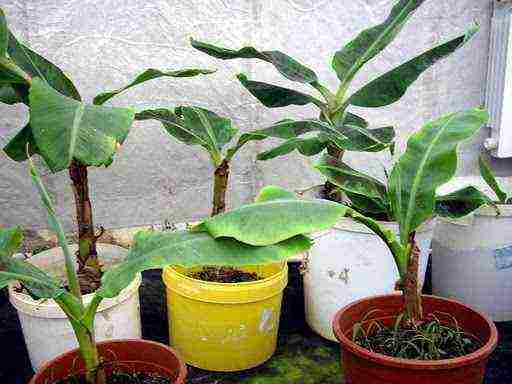
Basic guidelines for planting banana seeds:
• before planting, it is recommended to soak banana seeds in warm water for a couple of days. It is desirable that the temperature is maintained within the range of + 35 ° C - + 40 ° C;
• water can be changed, but no more than 2-3 times the entire period;
• after the expiration of the term, the seeds must be cleaned of the remnants of pulp, mucus;
• then the seeds are disinfected in diluted 10% bleach. After processing, the seeds are thoroughly washed in clean running water;
• planting into the ground is carried out at a distance of 8-10 cm from each other. However, it will be better if the seeds are planted in separate pots, then the risk of root damage will be minimal during transplantation.
A home-made banana may be less than the size of the plants displayed in flower shops and will not bloom soon. But grown in the microclimate of your particular home, it will be less likely to get sick and, most likely, will give the richest harvest.
Lighting
Homemade bananas need bright sunlight during the growing season. During the midday sun, many flower growers recommend shading a banana from strong heat. In winter, to ensure the normal growth of the banana, it is necessary to install additional lighting.
In the case of growing on a windowsill, you need to ensure that the leaves do not touch the glass (they can burn) and there is no draft. Sharp temperature changes do not affect the plant in the most favorable way, since it is still a tropical culture, sometimes the harsh weather of other countries is alien to it.
Preferably it is the southern window and further in descending order.The northern location is the most unfortunate, regardless of the time of year, the plant will require daily additional lighting.
Watering
Banana is not one of those plants that will forgive you overflowing or drought of an earthy coma. Watering the banana is necessary only after the topsoil dries out. Water the plant abundantly, until the first drops in the pan. By the way, it is advisable to immediately pour out excess water from the pan, since excessive waterlogging will lead to acidification of the earth and rot of the root system.
Overdrying the soil will lead to the death of the roots, and even if watering is resumed again, the surviving roots will not be able to fully provide nutrition to the vegetative part and it is quite possible that some of the foliage will die off naturally.
In summer, a banana is watered with abundantly settled water closer to room temperature. When the temperature drops to + 16 ° C, watering is significantly reduced. In the summer months, the banana simply loves daily spraying from a spray bottle.
This should be done in the morning or evening, to prevent the sun's rays from getting on wet leaves. In winter, spraying is either stopped altogether or carried out no more than 1 time per week.
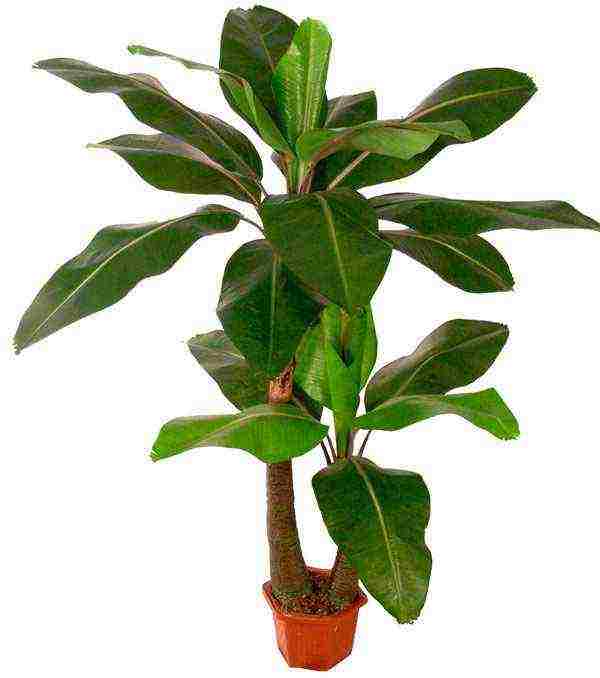
Pot selection
Despite the fact that the banana plant is unpretentious, an important part of its successful maintenance is the right choice of the pot. For young plants no more than 20 cm in height, a 2-3 liter pot is enough.
A plant that has exceeded the half-meter line can be safely transplanted into a container with a volume of up to 20 liters. The maximum pot size is 50 liters. However, it is important to remember that you should not immediately transplant the plant into a pot that is too large, as the roots may rot, which will make the plant unwell. There is no time for flowering.
Soil selection
Banana potting soil is easy to buy at any garden store, but you can make the potting mix you need yourself. To do this, we need an ordinary universal soil based on vermicompost (1 l), to which it is recommended to add river sand (2 l) and wood ash (0.5 l).
It is advisable to lay out the bottom of the pot with a layer of expanded clay for good soil drainage. The seedling is always planted a little deeper than it grew before. Thus, many adventitious roots are formed on its trunk, accelerating its growth and development. It is recommended not to clog the drainage holes, with their help oxygen will flow into the pot directly to the roots of the plant.
Top dressing
Indoor banana is fed during the growing season 1 time per week, during the dormant period no more than 1 time per month. Fertilizers based on vermicompost are perfect for feeding. Fertilize should only be done with liquid fertilizers during watering; by other methods of feeding, you can accidentally burn young developing roots.

Possible difficulties
Banana is practically pest free. Examine the leaves of the plant daily for pests or diseases, especially if you have a recently purchased copy that has not yet passed quarantine. As a preventive measure, you can loosen the top layer of the soil and sprinkle it with tobacco dust at least once a month. Also, some gardeners water the soil every six months with a weak solution of potassium permanganate. And avoid drafts!
Growing a banana at home is fairly easy compared to whimsical plants like azalea or orchid. The main thing is to monitor the degree and frequency of watering. A banana can be called ripe when 13–17 well-developed leaves are formed on it. Usually during this period, a huge bud is shown at the top of the plant in color closer to a red-purple hue. The flowering itself is often delayed for a year, during which the bud drops down and continues to form small rudiments of fruits, while other fruits are fully ripe.
To replace the already bored floral exoticism, the banana is increasingly becoming the subject of desire of many seasoned flower growers.Newbies who love this plant should also not be afraid to have a banana at home, since it is quite unpretentious and easily interferes with the size of the rooms. Try and experiment! Good luck!
How to grow bananas at home? Video.
